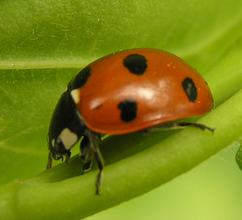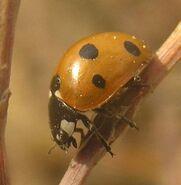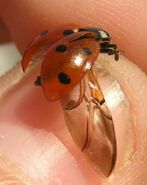Coccinella septempunctata (Linnaeus, 1758)[]
Arthropods (Arthropoda)---Insects (Insecta)---Beetles (Coleoptera)----Polyphaga----Cucojoidea----Ladybirds (Coccinellidae)---Coccinella---C. septempuncata

1st September, 2008.

9th June, 2008.

18th June, 2008. Larva.
This familar ladybird has been introduced into North America for biological control, even today they are being introduced, and are becoming very common. Along with the Convergent ladybird and some other species, these can be bought from gardening supplies for controlling aphids, mealybugs and scale insects. This ladybird always has 7 black spots, the size being variable, and the background colour of the Elytra being anywhere from orange to red, depending on how old the specimen is (they are pale yellow when they hatch from pupa, and gradually turn red later).
A fun thing to do with ladybirds is to place them on the bottom of one of your fingers and point that finger up in the air, normally the ladybird will climb up to the top of your finger and fly away. This species is recognizably larger than most of Alberta's species. There is still research on how the introduction is affecting the native ladybirds, species such as the Tamarack, Thirteen-spotted and Hieroglyphic ladybird have become increasingly rare today. Sometimes you may come across an adult with a crinkled, yellow side of the elytra, this is probably caused by a form of falling on its side or damage when the ladybird has hatched and its elytra are still very soft (they harden as they get older), they would (theoretically...) have been damaged in a way that stops the blood accessing that wing, thus stopping the colours from darkening.
Size[]
Large; 6-8mm.
Links[]

13th June, 2008. It is not uncommon to find specimens with extra black streaks and spots on.





